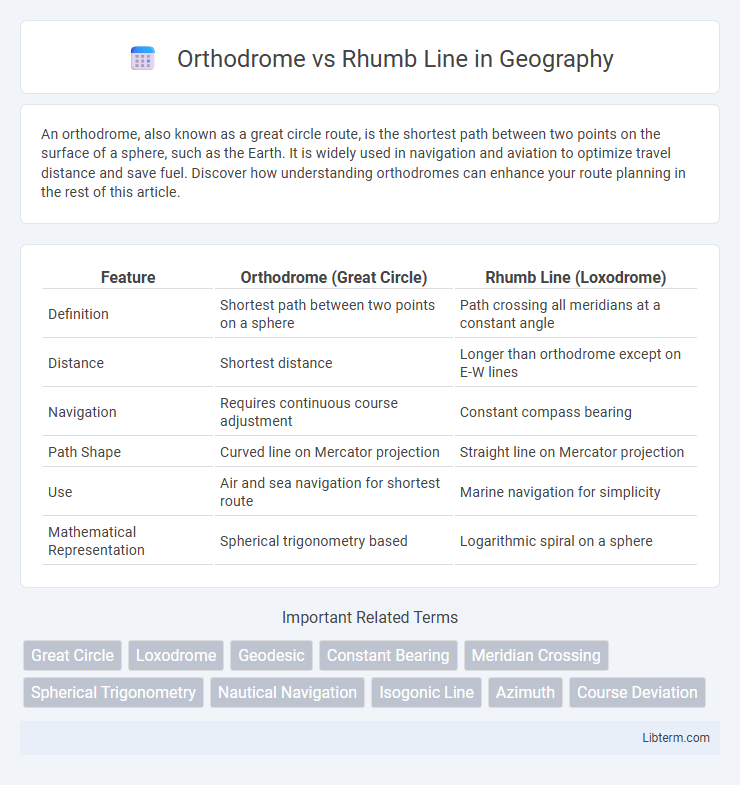An orthodrome, also known as a great circle route, is the shortest path between two points on the surface of a sphere, such as the Earth. It is widely used in navigation and aviation to optimize travel distance and save fuel. Discover how understanding orthodromes can enhance your route planning in the rest of this article.
Table of Comparison
| Feature | Orthodrome (Great Circle) | Rhumb Line (Loxodrome) |
|---|---|---|
| Definition | Shortest path between two points on a sphere | Path crossing all meridians at a constant angle |
| Distance | Shortest distance | Longer than orthodrome except on E-W lines |
| Navigation | Requires continuous course adjustment | Constant compass bearing |
| Path Shape | Curved line on Mercator projection | Straight line on Mercator projection |
| Use | Air and sea navigation for shortest route | Marine navigation for simplicity |
| Mathematical Representation | Spherical trigonometry based | Logarithmic spiral on a sphere |
Introduction to Orthodrome and Rhumb Line
Orthodrome, or great circle route, represents the shortest path between two points on a sphere, following the curve of the globe. Rhumb line, also known as loxodrome, is a path crossing all meridians at a constant angle, facilitating easier navigation despite being longer than the orthodrome. Both concepts are critical in cartography, aviation, and maritime navigation for route planning and distance optimization.
Defining Orthodrome: Great Circle Route
The orthodrome, also known as the great circle route, represents the shortest path between two points on the surface of a sphere, making it essential for efficient long-distance navigation. Unlike the rhumb line, which maintains a constant compass bearing but follows a longer, curved trajectory, the orthodrome accounts for Earth's curvature by tracing arcs of great circles. This navigation method minimizes travel distance and fuel consumption, making it the preferred route in aviation and maritime operations.
Understanding Rhumb Line (Loxodrome)
A Rhumb Line, or Loxodrome, is a path crossing all meridians at a constant angle, offering a straightforward navigational course for sailors and pilots. Unlike the Orthodrome, which is the shortest route between two points along a great circle, the Rhumb Line simplifies direction keeping a consistent compass bearing. This characteristic makes it essential for maritime and aviation navigation despite sometimes resulting in longer distances on a globe.
Mathematical Principles Behind Each Route
The orthodrome, or great circle route, is based on spherical trigonometry, representing the shortest path between two points on a sphere by following a geodesic curve, which minimizes distance on the globe's surface. The rhumb line, or loxodrome, maintains a constant compass bearing by crossing all meridians at the same angle, resulting in a spiral path converging towards the poles, described mathematically through Mercator projection coordinates and logarithmic spirals. These differing mathematical foundations reflect the orthodrome's efficiency in distance versus the rhumb line's simplicity in navigation.
Geographical Applications and Relevance
Orthodrome, or great circle route, represents the shortest path between two points on a sphere, crucial for optimizing long-distance air and sea navigation by reducing fuel consumption and travel time. Rhumb line maintains a constant compass bearing, simplifying navigation and plotting on Mercator projections, making it essential for coastal sailing and practical route following. Geographical applications favor orthodromes for efficiency in global routes, while rhumb lines support consistent directional control in regional and coastal navigation.
Navigation: Choosing the Optimal Path
Navigators must decide between the orthodrome (great circle) and rhumb line routes to optimize travel efficiency over long distances. The orthodrome offers the shortest distance between two points on a sphere, calculated using spherical trigonometry, ideal for fuel saving on intercontinental flights and shipping. Rhumb lines maintain a constant compass bearing, simplifying navigation though often resulting in longer paths, especially near the poles, making them preferable for straightforward course-keeping in coastal or short-distance voyages.
Advantages of Orthodrome Navigation
Orthodrome navigation offers the shortest route between two points on the globe, minimizing travel distance and saving fuel for long-haul flights and maritime voyages. This great-circle path optimizes efficiency by reducing time and operational costs compared to rhumb line navigation, which follows a constant compass bearing but results in longer distances. The orthodrome's precision is critical for accurate navigation in aviation and shipping, especially over polar or transoceanic routes where fuel economy and time are paramount.
Benefits and Limitations of Rhumb Lines
Rhumb lines, also known as loxodromes, maintain a constant compass bearing, simplifying navigation by enabling straightforward courses on a map. This advantage is particularly useful for sailors and aviators who require steady directional control over long distances. However, rhumb lines are not the shortest path between two points on a globe, often resulting in longer travel distances compared to orthodromes, which follow great-circle routes.
Real-World Examples and Use Cases
The Orthodrome, or great circle route, offers the shortest distance between two points on the globe, making it crucial for long-haul aviation and maritime navigation, such as flights between New York and Tokyo. In contrast, the Rhumb Line, maintaining a constant compass bearing, simplifies navigation for shorter coastal routes and is favored in shipping lanes like the Mediterranean Sea. Airlines and shipping companies weigh fuel efficiency and navigational ease when choosing between orthodromic and loxodromic paths for optimized route planning.
Conclusion: Which Route is Preferable?
The orthodrome, or great circle route, offers the shortest distance between two points on a sphere, making it the most fuel-efficient and time-saving option for long-haul navigation. The rhumb line, maintaining a constant compass bearing, simplifies navigation but results in a longer travel distance, increasing fuel consumption and travel time. For optimal route planning, the orthodrome is preferable in aviation and maritime contexts where minimizing distance and fuel use is critical, while the rhumb line may be favored for ease of navigation in less complex routes.
Orthodrome Infographic

 libterm.com
libterm.com